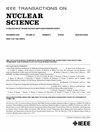20 厘米长 LYSO:Ce 和 BaF2:Y 晶体中的辐射损伤
IF 1.9
3区 工程技术
Q3 ENGINEERING, ELECTRICAL & ELECTRONIC
引用次数: 0
摘要
无机闪烁体广泛应用于高能物理(HEP)实验。明亮而快速的掺铈镥钇氧硅酸盐($text {Lu}_{2(1-x)}\text {Y}_{2x}\text {SiO}_{5}}\text {:Ce}$或 LYSO:Ce 或 LYSO)晶体正被用于建造高亮度大型强子对撞机(HL-LHC)上的紧凑μ介子螺线管(CMS)筒状定时层(BTL)探测器,在该探测器中,高达 2.5-Mrad 电离剂量、1.7 times 10^{13}$ 带电强子/cm2 和 2 times 10^{14}~\text {n}_{text {eq}}/\text {cm}^{2}$。掺钇氟化钡(BaF2:Y)晶体具有衰变时间小于 0.6 ns 的超快闪烁和被抑制的慢速成分,是一种很有前途的超快无机闪烁体,可用于未来的高能量、高强度飞行时间和热量计应用领域。20 厘米长的 LYSO:Ce 和 BaF2:Y 晶体在洛斯阿拉莫斯中子科学中心(LANSCE)的蓝光室接受了高达 7.5 \times 10^{15}$ p/cm2 的 800-MeV 质子束辐照。我们报告了它们的光学和闪烁特性的退化情况。本文章由计算机程序翻译,如有差异,请以英文原文为准。
Radiation Damage in 20-cm Long LYSO:Ce and BaF₂:Y Crystals
Inorganic scintillators are widely used in high-energy physics (HEP) experiments. Bright and fast cerium-doped lutetium yttrium oxyorthosilicate (
$\text {Lu}_{2(1-x)}\text {Y}_{2x}\text {SiO}_{{5}}\text {:Ce}$
or LYSO:Ce or LYSO) crystals are being used to construct the compact muon solenoid (CMS) barrel timing layer (BTL) detector at the high-luminosity large hadron collider (HL-LHC), where up to 2.5-Mrad ionization dose,
$1.7 \times 10^{13}$
charged hadrons/cm2, and
$2 \times 10^{14}~\text {n}_{\text {eq}}/\text {cm}^{2}$
are expected. With an ultrafast scintillation of less than 0.6- ns decay time and a suppressed slow component, yttrium-doped barium fluoride (BaF2:Y) crystal is a promising ultrafast inorganic scintillator for future HEP time of flight and calorimeter applications at the energy and intensity frontiers. The 20-cm-long LYSO:Ce and BaF2:Y crystals were irradiated by 800-MeV proton beam at the blue room of Los Alamos Neutron Science Center (LANSCE) up to
$7.5 \times 10^{15}$
p/cm2. We report on the degradation of their optical and scintillation properties.
求助全文
通过发布文献求助,成功后即可免费获取论文全文。
去求助
来源期刊

IEEE Transactions on Nuclear Science
工程技术-工程:电子与电气
CiteScore
3.70
自引率
27.80%
发文量
314
审稿时长
6.2 months
期刊介绍:
The IEEE Transactions on Nuclear Science is a publication of the IEEE Nuclear and Plasma Sciences Society. It is viewed as the primary source of technical information in many of the areas it covers. As judged by JCR impact factor, TNS consistently ranks in the top five journals in the category of Nuclear Science & Technology. It has one of the higher immediacy indices, indicating that the information it publishes is viewed as timely, and has a relatively long citation half-life, indicating that the published information also is viewed as valuable for a number of years.
The IEEE Transactions on Nuclear Science is published bimonthly. Its scope includes all aspects of the theory and application of nuclear science and engineering. It focuses on instrumentation for the detection and measurement of ionizing radiation; particle accelerators and their controls; nuclear medicine and its application; effects of radiation on materials, components, and systems; reactor instrumentation and controls; and measurement of radiation in space.
 求助内容:
求助内容: 应助结果提醒方式:
应助结果提醒方式:


